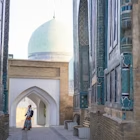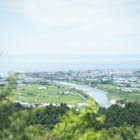
Top things to see in Japan during the Rugby World Cup
Jun 23, 2019 • 12 min read

Shibuya Crossing in Tokyo © Duane Walker
Anticipation is well and truly building for the Rugby World Cup 2019 in Japan. And while fans scramble to scoop up any last remaining tickets, the country is taking measures to ensure that it doesn’t run out of beer for the throngs of thirsty visitors.
With twelve diverse locations due to host matches, those travelling to Japan will have ample opportunity to tackle the country’s rich heritage and history, mouth-watering food scene, and unique culture. With this in mind, we've rounded up a selection of the must-see sights and activities in host cities.

Tokyo
See the city from Tokyo Metropolitan Government Building
Although it's a functioning government facility, this impressive building also doubles as a popular tourist destination. Both the north and south towers of building 1 include free observation decks that offer unbroken views of Tokyo from a height of 202 metres. Visitors can expect to catch sight of Tokyo Skytree and Tokyo Tower, and on clear days it may even be possible to see straight across to Mt. Fuji.
Witness a tuna auction at Toyoso Market
In 2018, Tokyo’s central wholesale market moved from its iconic location in Tsukiji to a brand new facility in Toyosu. Access is limited, but it has been specifically planned to accommodate visitors hoping to see the famous early-morning tuna auctions and other parts of the market from inside the glass-walled viewing platforms. Visitors can’t access the market floor, but the upper levels have shops and restaurants, including sushi counters that were originally at Tsukiji. Get there early to make the most of your visit.
Enter another world at Teamlab’s Borderless
Digital-art collective teamLab has created 60 artworks for this new museum inside the Mori Building Digital Art Museum in Odaiba that tests the border between the art and the viewer. The artworks are interactive, responding to touch and movement, and the digital projections can move beyond frames and bring guests inside the pieces. Buy tickets online in advance. Don't miss the magical Crystal World and Forest of Lamps (the latter you'll likely have to queue for). Elsewhere, the Athletics Forest is a collection of installations designed with children in mind. Visitors can colour in a drawing of an animal, insect or flower, and then watch as it is born into an animated creature. Take a break at the En Tea House, where you can see digital flowers bloom inside your cup of tea (¥500).
Pull up a seat at The Golden Gai
Aside from joining the bustling crowds at Shibuya Crossing and taking in a show at Robot Restaurant, few Tokyo night-time experiences are as iconic as a visit to The Golden Gai. A Shinjuku institution for over half a century, this collection of tiny bars has to be seen to be believed. The low-slung wooden buildings can often only accommodate a handful of visitors at a time, and each one has its own unique identity, theme and decoration. Some bars prefer to keep their doors closed to customers who aren’t regulars, while others welcome tourists (if there is space). It’s best to wander through the lanes and pick a place that suits your mood. Bars welcome to tourists will have English signs outside their doors. Keep in mind, many of them have a cover charge between ¥500 to ¥1500.

Sapporo
Find peace at Hokkaidō-jingū
Dating back to 1869, this is one of the oldest shrines in Hokkaidō and is known for its spectacular cherry and plum blossoms in spring. A popular “power spot”, it is beloved by many citizens, and is said that visitors will be granted good luck in business and good fortune with money, seeing as the god of prosperity is enshrined here.
Get a taste of history at Sapporo Beer Museum
This legendary attraction is in the original Sapporo Beer Brewery, a beautiful ivy-covered brick building that is the proud home to Japan’s oldest beer. Guided tours are available, although there is plenty of information in English without one. The museum includes a tasting salon where visitors can compare Sapporo’s signature Black Label with Sapporo Classic (found only in Hokkaidō) and Kaitakushi Pilsner, a re-creation of the original recipe that is only available to try there. Afterwards, head next door to the Sapporo Biergarten for more beer and jingisukan (all-you-can-eat lamb dish).
Stroll the gardens of Hokkaidō University’s Sapporo Campus
Established in 1876, this large university campus is a picturesque and beautiful spot, with a number of unique buildings, including the Furukawa Memorial Hall and the Seikatei. The university’s lawns and parks are perfect for a walk, while the 14-hectare outdoor botanical garden houses a collection of 200 plants and herbs. There's also a landscaped section that evokes the alpine scenery of a mountain in Daisetsuzan National Park in northern Hokkaidō.

Kamaishi
Climb Kamaishi Daikannon
Towering over the industrial fishing town of Kamaishi is a leviathan 13-story high white Buddha statue. Built in 1954, the base of the statue houses a temple, while visitors can enter it and climb up through the interior to an observation deck formed by the fish held in the Daikannon’s arms. Here they are met with stunning panoramic views of the bay.
Learn about local industry at the Iron and Steel Museum
Opened to commemorate the history of the iron industry in Kamaishi City, this museum includes a theatre that shows educational videos with modern audio-visual technology that highlights a replica of the oldest western blast furnace in Japan. There are also exhibitions that explain the background of steel production, although all of the information is in Japanese. Visitors can stop by an observation lounge to catch nice views of Sanriku Coast.

Kumagaya
Escape to nature at Musashi-Kyuryo National Government Park
Set on an expansive 304-hectare hilly area, Japan’s first government park includes grassy lawns, ponds, swamplands, athletic courses, cycle paths and orienteering courses, as well as play areas with trampolines. A natural getaway in the city, it also offers visitors the chance to relax in beautiful herb gardens and picnic areas.
Float down the Nagatoro River
Approximately one hour away from Kumagaya by train, Nagatoro is a popular spot for outdoor enthusiasts, partly due to the fact that the entire town has been designated as a prefectural natural park and preserve. River boating here is an unmissable experience, with companies running cruises carrying about 20 passengers in boats steered by two men with long poles.

Yokohama
Admire the greenery at Sankei-en Garden
A beautifully landscaped garden that was established by the wealthy silk trader Sankei Hara and opened to the public in 1906, this tranquil space has paths winding between ponds that lead to 17th-century buildings, tea-ceremony houses and a 500-year-old three-storey pagoda. A highlight is exploring inside the old Yanohara Family Residence in the Outer Garden, an Edo period abode transplanted from Gifu Prefecture in the 1960s. Free English-language tours are available at 2pm on Mondays, Wednesdays, Thursdays and on weekends.
Design your own instant snack at the Cup Noodles Museum
Step inside a museum dedicated to the 1956 invention of instant ramen by Momofuku Ando. The impressively slick and popular attraction has a host of unique exhibits that drive home the message to go against the grain, be creative and 'Never give up!'. The highlight is the chance to design your own Cup Noodle (which costs an additional ¥300) to take away.

Toyota
Visit the Toyota Municipal Museum of Art
Designed in 1995 by architect Yoshio Taniguchi, this museum mainly houses ambitious and unique contemporary works of art. It attracts visitors from both inside and outside the prefecture, and the mix between the contemporary art and the eye-catching architecture enables visitors to feel as if they have stepped into another world.
Catch a train to Nagoya
Approximately an hour away from Toyota by Train is Nagoya, a city rich in industrial history that boasts many interesting museums, including the Tokugawa Art Museum, Nagoya City Science Museum and the Toyota Commemorative Museum of Industry & Technology, where car enthusiasts can learn more about the world’s largest car manufacturer.

Shizuoka
Find serenity at Ryōtan-ji Temple
An ancient temple in the Oku Hamanako region that honours forty generations of the Ii family, Ryōtan-ji Temple is designated as an official “Place of Scenic Beauty” in Japan, due in part to its stunning garden as well as the on-site forest that is beautiful in any season. The south section is a more traditional zen garden composed of sand and stones. Visitors can take a bus from Hamamatsu straight to the temple's bus stop.
View the land and sea from the Tenryu Hamanako Railroad
Commonly referred to as the Tenhama Line, this rail line runs along the north coast of Lake Hamana from Kakegawa Station to Shinjohara Station for 67 kilometres. The charming retro character of the railway cars make for a unique travelling experience as you can gaze with nostalgia on the Japanese landscape.
Kobe
Wander around Kitano-chō
This pleasant, hilly neighbourhood includes a dozen well-preserved homes of mostly Western trading families and diplomats who settled in the area during the Meiji period. These ijinkan (literally 'foreigners' houses') are curiously unique and diverse, as each is built in the architectural style of the owner's home country. Now they are mostly cafes, restaurants and souvenir shops. It’s well worth a visit, and when you’ve walked up an appetite, be sure to call into a local favourite to try the world famous beef.
Sample some deliciousness at Hakutsuru Sake Brewery Museum
A major mover in Kōbe's sake-brewing district of Nada-gogō, here visitors can take self-guided tours through the old wooden brewery (the modern brewery is behind it) to get a fascinating look at traditional sake-making methods. Footage is shown in English from inside the original brewery alongside old equipment, and of course, you get to sample some sake at the end.

Higashi-Osaka
Climb Osaka Castle
Originally built as a display of power by General Toyotomi Hideyoshi after the unification of Japan in the late 16th century, today, the present structure is a 1931 concrete reconstruction (refurbished in 1997), but is nonetheless a wonderful sight, standing dramatically over the surrounding park and moat. Inside is a collection of art, armour, and day-to-day implements related to the castle, Hideyoshi and Osaka, while an 8th-floor observation deck offers 360-degree views of the city.
Soak in the neon of Dōtombori
If you ever want to feel like you've just stepped into a futuristic world where neon reigns supreme, then a stroll through Dōtombori is a must. The highly-photogenic neighbourhood is Osaka's liveliest night-time spot, and offers an abundance of things to eat and drink. Don't miss the famous Glico running man sign

Oita
Stimulate your mind at Oita Prefectural Art Museum
Not to be confused with the nearby Oita City Museum (which you can also call into while you’re there), Oita Prefectural Art Museum opened in 2015 inside an eye-catching building designed by architect Shigeru Ban. The museum has a collection of contemporary arts and crafts that are famous in Oita, and has showcases that includes paintings, sculptures, poetry and performance art.
Bathe in natural onsen in Yufuin
Approximately 25km inland from Beppu, is Yufuin, a town that sits in a ring of mountains, with the twin peaks of Yufu-dake especially notable. It’s a great place to see contemporary Japanese crafts, including ceramics, clothing and woodworking. It’s also an onsen resort, with plenty of options for bathing in ryokans and guest houses. The town can get very busy, so an overnight stay is advised as the day-trippers leave on buses before evening. Another natural landmark in Yufuin is Lake Kinrin, located at the end of the town's main walking route approximately a kilometer and a half from the station.

Fukuoka
Find enlightenment and education at Dazaifu Tenmangū
The main hall of this shrine was built over the grave of Sugawara Michizane, venerated by the Japanese as a deity of scholarship and sincerity, literature and calligraphy. The shrine attracts around 10 million visitors each year. The grounds are lively, and the entire length of the road up to the shrine are lined with shops, gift stalls, cafés, and snack bars. After passing through a tori gate, visitors will come across a pond to a path leading across two arched bridges and an island that represent the past, present and future. Inside the walled courtyard is the shrine’s main hall which dates back to 1591.
Get a glimpse of history at Hakata Machiya Furusato-kan
Spread over three machiya (traditional Japanese townhouses), this folk museum re-creates a Hakata nagare (neighbourhood unit) from the late Meiji era. Inside the replica buildings, artisans demonstrate local crafts, with galleries that show historical photographs and displays of traditional Hakata culture (festivals, crafts and performing arts), as well as recordings of the impenetrable Hakata-ben dialect. The gift shop has an interesting selection of traditional toys and crafts.

Kumamoto
Catch a glimpse of Kumamoto-jō
Although it was seriously damaged during an earthquake in 2016, Kumamoto Castle still remains the focal point of the city, and is well worth a visit. The castle's massive curved stone walls are crammed with 13 photogenic buildings, turrets, keeps and the soaring black Tenshūkaku (main building). Though it's a reconstruction, Kumamoto-jō is best known as the scene of the story of the last samurai. During the 1877 Satsuma Rebellion, rebels against the new imperial order held out through a 50-day siege here before the castle was burned, leaving the Meiji government to rule unfettered. Outside the main keep but still within the castle walls, several museums remain open, including the Kumamoto Prefectural Museum of Art, its postmodern Chibajo branch and a crafts centre.
Gaze in wonder at Suizenji-jōjuen
Southeast of the city centre, lies this photogenic lakeside garden built between 1636 and 1716 for the ruling Hosokawa clan. The main path represents the 53 stations of the Tōkaidō (the feudal road that linked Tokyo and Kyoto). There is a tranquil walk through groves of palms and hydrangeas to a large Shintō shrine. During the 2016 earthquakes the garden's pond drained and groundskeepers hand-carried the many carp to safety tanks, replacing them after the pond refilled.

Get more travel inspiration, tips and exclusive offers sent straight to your inbox with our weekly newsletter.
Explore related stories

Wildlife & Nature
Lonely Planet staffers pick their favorite travel photos of 2024Dec 31, 2024 • 5 min read



 Festivals & EventsThe 12 best places to witness the winter solstice in 2024
Festivals & EventsThe 12 best places to witness the winter solstice in 2024Dec 9, 2024 • 8 min read



 Festivals & EventsChristmas dinners around the world: choose your favorite festive dishes
Festivals & EventsChristmas dinners around the world: choose your favorite festive dishesNov 22, 2024 • 5 min read









